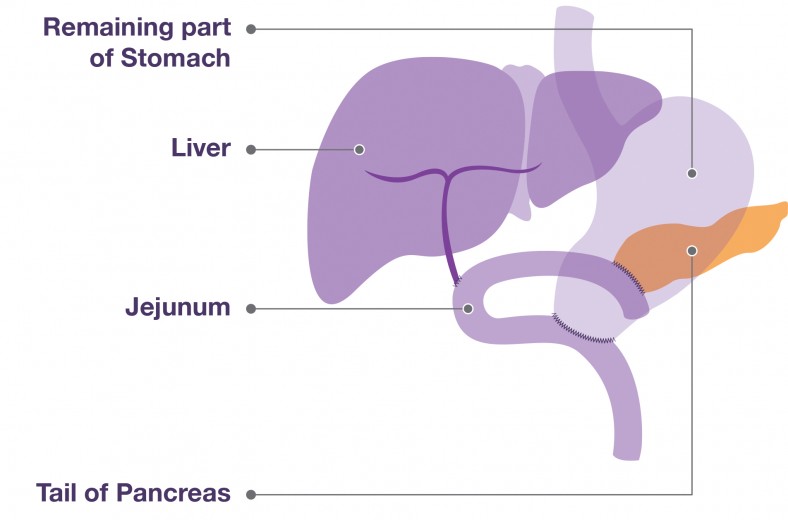Whipple's Procedure and Pylorus Preserving Pancreatoduodectomy (PPPD)
Whipple’s procedure
The Whipple’s procedure (or pancreaticoduodenectomy, [‘PD’]) is the most common type of surgery to remove pancreatic tumours.The procedure involves removal of the “head” (wide part) of the pancreas next to the first part of the small intestine (duodenum). It is usually only carried out if the cancer has not spread beyond the head of the pancreas and patient is in good enough health to withstand a major operation.
What happens during a Whipple’s procedure operation?
The diagram (below) shows the stomach, liver, pancreas, gallbladder, small intestine and pancreas of a patient with a tumour in the head of the pancreas. The dotted lines show the area to be resected (cut out).

The head of the pancreas, a portion of the bile duct, the gallbladder and the duodenum (first part of the small intestine) are removed, along with part of the stomach. The rest of the pancreas, the bile duct and the stomach are reattached to the small intestine (see diagram below). This allows the pancreatic enzymes, bile and food to flow out into the gut, so that digestion can proceed normally. Nearby lymph nodes may also be removed.

Pylorus preserving pancreatoduodectomy (PPPD)
The Pylorus Preserving Pancreatoduodectomy (PPPD) is a modified Whipple’s procedure. In this case, only part of the duodenum is removed and the pylorus (the part of the stomach that connects to the duodenum) is kept. Some doctors think this helps with food digestion after the operation.
There is no evidence however, that one of these operations works better then the other. It is often a technical decision, ask your surgeon if you have any questions about your operation.
Both the Whipple’s procedure and PPPD operations are major operations with risks of complications. You will need a general anaesthetic to keep you asleep during surgery and you’re likely to need around ten days recovering in hospital.


 The information provided in this site, or through links to other websites, is not a substitute for medical or professional care and should not be relied upon as such. Read our disclaimer.
The information provided in this site, or through links to other websites, is not a substitute for medical or professional care and should not be relied upon as such. Read our disclaimer.
Sources and references for this information product will be supplied on request. Please contact us quoting the Information Product number below:
| Information Product № | PCA0012 v1 pgs 6 - 9 | Published | 09/10/2019 |
|---|---|---|---|
| Last Updated | 30/03/2020 | Next Review Due | 02/09/2022 |